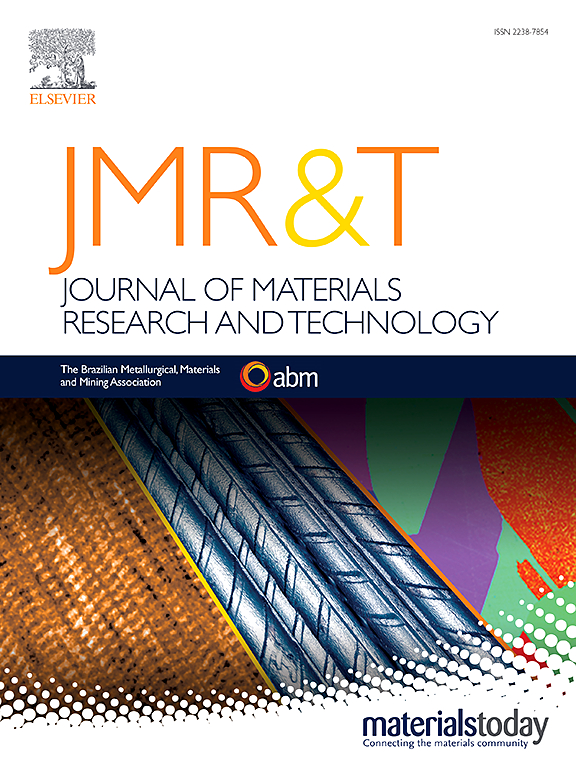Investigation of variations of metallurgical and morphological phenomena of interface in the magnetic pulse welding of Al–Cu
IF 6.2
2区 材料科学
Q1 MATERIALS SCIENCE, MULTIDISCIPLINARY
Journal of Materials Research and Technology-Jmr&t
Pub Date : 2025-03-13
DOI:10.1016/j.jmrt.2025.03.093
引用次数: 0
Abstract
This study investigates the bonding interface characteristics, formation mechanisms of metallurgical bonds, and intermetallic compounds in Al–Cu joints produced by magnetic pulse welding (MPW) using an E-type coil. Welding was conducted at a discharge voltage of 16 kV and an air gap of 1 mm. Field-emission scanning electron microscopy (FE-SEM) analysis revealed that the bonding interface characteristics vary with increasing distance from the collision centerline. In addition, the X-ray diffraction (XRD) analysis identified the formation of intermetallic compounds of AlCu, AlCu4 and Al4Cu9 at the bonding interface. The collision angle increases and collision energy decreases with distance from the centerline, resulting in two distinct zones: a high-shear zone near the collision centerline (Zone 1) and a low-shear zone near the bond edge (Zone 2). The AlCu intermetallic compound was predominantly formed in the high-shear zone, while AlCu4 and Al4Cu9 were observed in the low-shear zone. The formation mechanism of these intermetallic compounds is attributed to solid-state diffusion, as no signs of melting were detected in the transition zones of the bonding interface, except in the porous zone. Additionally, the bonding interface exhibited higher strength compared to the base metals of Al and Cu.
Al-Cu磁脉冲焊接中冶金学变化及界面形貌现象的研究
研究了e型线圈磁脉冲焊接Al-Cu接头的结合界面特征、冶金键的形成机制和金属间化合物。焊接时,放电电压为16kv,气隙为1mm。场发射扫描电镜(FE-SEM)分析表明,键合界面特征随距离碰撞中心线的增加而变化。此外,x射线衍射(XRD)分析发现,在键合界面处形成了AlCu、AlCu4和Al4Cu9金属间化合物。随着距离中线的增加,碰撞角度增大,碰撞能量减小,形成两个明显的区域:靠近碰撞中心线的高剪切区(1区)和靠近键边的低剪切区(2区)。高剪切区主要形成AlCu金属间化合物,低剪切区主要形成AlCu4和Al4Cu9金属间化合物。这些金属间化合物的形成机制归因于固态扩散,因为在结合界面的过渡区没有检测到熔化的迹象,除了在多孔区。此外,与母材Al和Cu相比,结合界面表现出更高的强度。
本文章由计算机程序翻译,如有差异,请以英文原文为准。
求助全文
约1分钟内获得全文
求助全文
来源期刊

Journal of Materials Research and Technology-Jmr&t
Materials Science-Metals and Alloys
CiteScore
8.80
自引率
9.40%
发文量
1877
审稿时长
35 days
期刊介绍:
The Journal of Materials Research and Technology is a publication of ABM - Brazilian Metallurgical, Materials and Mining Association - and publishes four issues per year also with a free version online (www.jmrt.com.br). The journal provides an international medium for the publication of theoretical and experimental studies related to Metallurgy, Materials and Minerals research and technology. Appropriate submissions to the Journal of Materials Research and Technology should include scientific and/or engineering factors which affect processes and products in the Metallurgy, Materials and Mining areas.
 求助内容:
求助内容: 应助结果提醒方式:
应助结果提醒方式:


